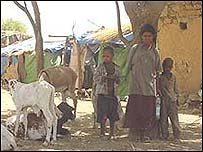7 December 2005,
Ethiopian opposition to handing over the small town of Badme to Eritrea has until now prevented an international border commission ruling in 2002 being implemented – and left the uneasy peace struck when war ended in 2000 in the balance. With Eritrean frustration building, the UN’s role monitoring the ceasefire has come under scrutiny.
The BBC News Website examines the main issues behind the border conflict.
How did the border conflict begin?
The border between Ethiopia and Eritrea has been described as a geographer’s nightmare.

Dusty Badme was at the centre of the border dispute
|
It is a nightmare which became a reality as soon as the neighbours’ once-friendly relationship turned sour.
From 1962 to 1993, Eritrea was ruled as a province of Ethiopia – and any argument over the borders was little more than a squabble between two local authorities.
So when Eritrea and Ethiopia separated amicably in 1993, no one paid too much attention to the details of the divorce settlement – least of all to a few hundred square kilometres of sparsely populated land in a region called Badme which included a small dusty town of the same name.
But when relations between the two neighbours deteriorated, Ethiopia accused Eritrea of invading a piece of land that was under Ethiopian administration.
The Eritreans replied that the land in question was rightfully theirs.
The result was a war fought on three fronts at the cost of tens of thousands of lives.
Who set up the boundary commission?
The commission was set up by the two countries as part of the Algiers peace settlement signed by both parties in 2000.
It followed a model that has been used in other cases around the world, where arbitration tribunals, instead of the International Court of Justice, have been used.
There were five lawyers – including two nominated by each country, who then nominated a president of the commission who has the casting vote.
So what were the Commission’s terms of reference?
The commission was asked to interpret colonial treaties as the basis for the boundary.
This frontier was fixed in 1902 by a treaty between the Italian government, which had colonised Eritrea, and the Ethiopian Emperor Menelik II – ruler of what was then one of the few independent African states.
The border is approximately 900 km long, and contains some of the driest, hottest and most hostile territory in the world. Part of it is defined by rivers.
Most of the border area under dispute is sparsely inhabited – barren land used as traditional grazing grounds by local people.
In terms of natural resources, the disputed area has virtually no value at all.
Both countries promised the UN that they would accept whatever decision was reached and there was no right of appeal.
What was the ruling and why was it not implemented?
Much of the commission’s ruling in May 2002 was not contentious, but Ethiopia objected to the awarding of Badme to Eritrea – although the town was controversially not marked on Eritrea’s map.
After seeking clarification and failing to get the commission to reverse its decision, Ethiopia insisted on talks before it would co-operate with the physical demarcation of the border.
Since then the UN has become increasingly frustrated at the cost of maintaining a peacekeeping force along the narrow buffer zone on the border.
Diplomatic attempts to get the two sides talking have faltered – primarily because Eritrea has refused to discuss the issue until Ethiopia accepts the ruling – something which until now Ethiopia has failed to do.
So what happens next?
Maintaining a state of hostility is not in the interests of either Ethiopia or Eritrea, and the closure of their border is deeply damaging to both sides.
In theory, Ethiopia Prime Minister Meles Zenawi’s announcement in parliament that his government accepts the ruling “in principle” could enable talks to begin if Eritrea agrees.
It also permits diplomats to push ahead with efforts to resolve the Badme issue in a way which allows both sides to claim they have not lost.
One possibility is that Ethiopia could continue to administer Badme, while acknowledging Eritrean sovereignty over the area. It might even be possible, with a little goodwill, to agree to a joint administration of Badme.
The reality is, though, that the physical demarcation of the border placing Badme in Eritrea still looks a long way off – and remains a very bitter pill for Ethiopia to swallow.
The danger is that Eritrean frustration might provoke renewed conflict.
What is the role of the UN peacekeepers ?
Shortly after the peace deal in 2000, the UN Security Council set up Unmee and authorised a force of up to 4,200 military personnel to monitor the ceasefire and ensure the security aspects of peace deal are observed by both sides.
Expected to be there for a short period, UN troops are operating in some of the most inhospitable terrain in the world. They patrol an area some 25km wide and 900km long on the Eritrean side of the border with Ethiopia.
At present there are some 3,300 peacekeepers and military observers from some 40 countries, 191 civilians and 74 UN volunteers working for Unmee. Some 1,500 Indian troops provide the largest contingent in the force which is led by Major-General Rajender Singh.
But their continuing presence five years after a peace deal has become a costly headache for the UN. The bill is now $1bn and rising.
With recent restrictions imposed on their activities by Eritrea the UN forces are being left in an increasingly untenable position and with little prospect of border demarcation, the chances of the force being pulled out must be growing.
However, to leave now would be seen by critics as an expensive UN failure.
BBC
